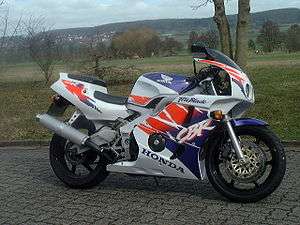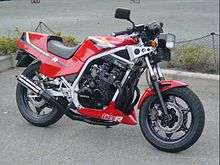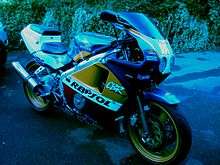Honda CBR400
The Honda CBR400 is a Japanese domestic market small-capacity sport motorcycle, part of the CBR series introduced by Honda in 1983. It is the first Honda motorcycle to wear a CBR badge.
 | |
| Manufacturer | Honda |
|---|---|
| Also called | CBR400F, CBR400R, CBR400RR |
| Production | 1983–1994 2013–present (CBR400R) |
| Class | Sport bike |
| Engine | 399 cc (24.3 cu in), air-cooled, DOHC, four-stroke, 16v, inline-4 |
| Bore / stroke | 55.0 mm × 42.0 mm (2.17 in × 1.65 in) |
| Top speed | 179 km/h (111 mph)[1] |
| Ignition type | Electric starter |
| Transmission | 6-speed, manual, chain final drive |
| Brakes | F: Double disc R: Disc |
| Wheelbase | 1,410 mm (55.5 in) |
| Dimensions | W: 650 mm (25.5 in) |
| Seat height | 780 mm (30.8 in) |
| Weight | 211 kg (465 lb)[1] (wet) |
| Fuel capacity | 15 l; 3.3 imp gal (4.0 US gal) |
The CBR400R (NC17 ) naked bike was launched in December 1983. The 4-valves per cylinder, air-cooled, four-stroke, DOHC, inline-four engine had a rotational-speed valve stop mechanism "REV" (a prototype of Honda's VTEC system) that changed from two valves into four valves at 9,500 rpm. The following two years, it came as semi- and fully faired version as the F3 Endurance. The CBR400R and early CBR400RR models both carry the model number NC23, which makes up the first part of these bikes' frame numbers. In 1986 the CBR400R was also known as Aero, Jellymould, as it shares its major design features with the rest of the early CBR600F and CBR1000F Hurricane family of motorcycles,[2] which included significantly rounded body shapes. whereas the later 1988 model was designated CBR400RR and was also known as the Tri-Arm,[2] after its racing inspired braced swingarm.

The CBR400RR in 1992 was referred to as the ‘Baby Blade’ replica, then in 1994 it was styled to closely look like the CBR900RR or Fireblade motorcycle.[2] though over the years, in performance and handling it was more closely compared to the CBR600.[2] The CBR400RR preceded the 900 cc (55 cu in) Fireblade by four model years, going through one major rework (signified by a new "gull-arm" swing arm design.
The CBR400RR models are the NC23 and NC29 CBR400RR-J (1988), CBR400RR-K (1989), CBR400RR-L (1990–1991), CBR400RR-N (1992–1993) and CBR400RR-R (1994).[3] The name "Tri-Arm" is shown on the CBR400RR-J's bodywork, along with Hurricane, but the CBR400RR-K dropped the latter designation.[4]

The NC23 CBR400RR features a standard extruded beam frame, the rear of the seat unit slopes forwards, and the seat unit subframe is totally separate from the main chassis of the bike. The NC23 & NC29 (only the -R models of which carry the FireBlade name) had several modifications to the frame. The main rails were of a 'cranked' design, the seat support structure had a larger rail that was welded to the frame, the rear of the tail section now had a slight recurve to it, and the swingarm was given a gull-wing shape on one side to give ground clearance for the exhaust link pipe.
In 1985, Honda brought a CBR400F to the US for testing, on which Cycle World recorded a 0 to 1⁄4 mi (0.00 to 0.40 km) time of 13.63 seconds at 95.94 mph (154.40 km/h) and a top speed of 179 km/h (111 mph).[1]
In 2013, Honda released the new twin-cylinder CBR400R along with its naked model, the CB400F (not to be confused with four-cylinder CB400 Super Four), and sport adventure model, the CB400X, which is based on the CBR500R, CB500F, and CB500X respectively. These models are sold in Japan & Singapore only.[5]
Notes
- "Honda CBR400F; A Question of Environment", Cycle World, vol. 24 no. 5, pp. 96–104, May 1985
- Hargreaves, Simon (August 1, 2016). "The Golden Age of Sports 400s". MCN. Retrieved January 9, 2018.
- Coombs, M: "Honda CBR400RR Service and Repair Manual, p. 8, Haynes Publishing, 2005
- Honda CBR400R and CBR400RR model brochures, Honda Motor Co., Japan [various years]
- "Honda CBR400R Resmi Diaspalkan". Otosia. 2013-06-01. Retrieved 2016-07-29.
References
- Anderson, Steve (February 1987), "The High Tech 400s; Japan's 400 class opens a window to our motorcycling future [sidebar] Honda CBR400R; Father of the Hurricane", Cycle World, vol. 26 no. 2, pp. 34–41
- Cook, Marc; Gillies, Mike; Gingerelli, Dain; Smith, Jerry; Wolf, Bill (February 1987), "Japan's best-kept secrets", Cycle Guide, vol. 21 no. 2, pp. 20–
- Lindemann, Mark (May 1985), "Honda CBR400F: the 13,000-rpm wristwatch", Cycle, vol. 36 no. 5, p. 26